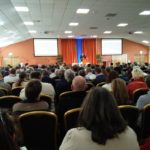Bishop Steven’s Opening Address to the Living Waters Clergy Conference
“Then he brought me back to the entrance of the temple; there water was flowing from below the threshold of the temple towards the east…”
(The following address was recorded at the Living Waters clergy conference. Listen to it and other talks from the conference on SoundCloud)
A warm welcome to our clergy conference. It’s good to see you. Every single person. I hope these four days will be a gift from God, a means of renewal in grace, a deepening of community and trust and friendship, a way of discovering what God is doing among us.
Thanks to all who have prepared this conference for us and have served us. Thanks to those who have prepared worship and workshops and every part of the programme and welcomed us. Thanks to those who will come and speak to us. We have done our best to make sure that everything is as good as it can be. Even so the most important parts of the conference will be in the spaces and the interaction between us: the friendships that will form and deepen and the business we will do with God.
We gather together as a large community and thank God for one another. Please lets look out for one another as we gather. It’s easy to be lost in such a big crowd. We need to treat one another as adults and make our own decisions about how best to engage but also be concerned for each other particularly in the small groups which make up an important part of the conference. No leaders have been designated for those groups. We take responsibility for them together.
We will do our best to welcome and care for one another but our particular thanks and welcome to our chaplains, Sister Sue, Brother Joseph Emmanuel and Brother Philip Bartholemew. They are available to us throughout the conference and the Chapel is also available as quiet prayer space.
And a particular welcome to those who have come to join us from the dioceses of Kimberley and Kuruman, Vaxjo and Nandyal. I have been to K and K and Vaxjo in the last six months and as Meatloaf sang, two out of three ain’t bad.
The Bible passage before us as we have planned this conference is Ezekiel’s vision of the river of life flowing from the temple.
I would not want you to think that this is just any old moment in the story of the Old Testament. It isn’t. I don’t think you have understood the Old Testament until you understand this. Ezekiel 47 represents the lowest point in the entire narrative and also the turning point.
Let me remind you of the story. God delivered his people from slavery and established them as a nation. There were judges and then there were kings as the power of Israel grew. Jerusalem was established as a city with a temple in the city where God was present.
Then immediately that earthly power waned. The nation was divided. Worship was corrupted. The northern kingdom fell to Assyria. The southern kingdom rallied then was overcome by Babylon. Jerusalem was taken. The temple was destroyed. The best of the nation were taken into exile.
For two generation the prophets and theologians wrestled with all that happened. Why has the nation been so destroyed. Their answer: we deserved it. We were under a curse.
For 25 years at the time of this prophecy the nation has been in exile and Jerusalem a wilderness. Ezekiel has wrestled all of his life with how hope can be restored. The only way back is grace. All renewal is in God’s hands. All renewal flows from a fresh and powerful vision of God.
Finally at the end of his great prophecy, Ezekiel sets out his vision, his plan for the new temple. The House of God is describe to the smallest detail in seven of the dullest chapters in the entire Bible. All is made ready. There is seemingly no life here.
But then, at the end of it all, at the point of deepest despair:
“Then he brought me back to the entrance of the temple; there water was flowing from below the threshold of the east and the water was flowing down from below the south end of the threshold of the temple, south of the altar. Then he brought me out by way of the north gate and led me round on the outside of the outer gate that faces towards the east; and the water was coming out on the south side”.
Here is where the entire story turns: here in Ezekiel 47. From this point on we will be looking forward in hope to the coming of the Christ. This is the moment of desolation and the moment of renewal. A tiny trickle of water, so small, a teardrop of grace flowing from the place of prayer and sacrifice out into the desert.
This is living water. Everything in the story points to the power of the life it holds. It comes from God, from grace alone. First there is the way the water grows and deepens as it flows. The only measurement taken is the depth of the water of life: after one thousand cubits, ankle deep; after another thousand knee deep; another thousand, waist deep; Another thousand and it is deep enough to swim in, a river no one could cross. Mortal have you seen this?
Next there is the effect of the water of life on the desert where nothing grows. In the length of time it takes to walk out four thousand cubits and then back, there are trees on each side of the river. These are all kinds of trees for food. This is the new Garden of Eden. This is a new creation. There is no forbidden fruit. There is a harvest not once a year but every month. Their fruit will be for food and their leaves for healing.
Next and greatest of all there is the effect of this river on the landlocked sea south of Jerusalem known all over the world as the Dead Sea. The clue is in the name. The Dead Sea is 1,400 feet below sea level, earth’s lowest elevation on land. It is almost 1,000 feet deep, 30 miles long and nine miles wide. The Jordan flows into it. Nothing flows out of it.
The Dead Sea has its name for a reason. It is completely dead. Nothing lives in that vast expanse of water. There are no fish. There are no aquatic plants. There are miniscule quantities of bacteria and fungi. But the world over, the Dead Sea is the only place where David Attenborough cannot make a documentary. It is the one place on the entire surface of the planet where there are no plants or animals and no life.
What happens when this tiny trickle of water, this teardrop from the place of prayer and sacrifice, has grown into a stream and then a river and enters the sea, the sea of stagnant waters. The waters will come fresh. Such is the power of this living water.
“It will become fresh and everything will live where the river goes. People will stand fishing beside the sea from Engedi to Eneglaim; it will be a place for the spreading of nets; its fish will be of a great many kinds, like the fish of the Great Sea”.
Everything will live where the river goes.
This is the turning point. This is where the great movement from death to life begins in the great sweep of the story of salvation. It begins with a prophet who has lived 25 years with the failure of his nation in which he shares. Yet his vision of God and the grace of God overcomes even the desert and the Dead Sea and the destruction of his nation. He is able to imagine a river of life which will overcome even death itself and change everything.
Three times John’s Gospel points us back to Ezekiel 47. With the woman at the well we read of this living water: “The water I will give will become in them a spring of water – or literally a well of water – gushing up to eternal life” (John 4.14). In John 7, Jesus stands up on the last and greatest day of the feast and calls out:
“Let anyone who is thirsty come to me and let the one who believes in me drink. As the scripture has said, “Out of the believer’s heart shall flow rivers of living water”.
Now he said this about the Spirit (John 7.38).
And in the story of the passion, as they pierce his side, blood and water flow out (20.34). The stream of living water flows from the place of prayer and sacrifice. Everything will live where the river goes.
This may not be the lowest point ever in the life of the Church of England or the Church of Jesus Christ. Each generation has its own challenges in the world and in the life of the Church. But it is a moment where significant renewal is needed.
There is no doubt in my mind though that as humanity and as the Church we do face significant challenges.
As we seek to develop fresh vision, we need God’s renewing grace and power.
It will not do simply to prescribe easy remedies and solutions and tell each other what to do as if we knew. It will not do simply to dwell in our decline and somehow expect new life to come. It will not do to place still more burdens on the shoulders of clergy or congregations and expect more with less.
The only place to begin is by coming again to the living waters. We need to dig the wells, to unblock the springs of new life. To come again to the place of prayer and sacrifice and stay long enough to notice what God is doing, the beginning of the river’s source, new life. We need to come again to the living waters of our baptism, of repentance and faith, to die and rise again, to put on Christ.
As we seek fresh vision as diocese we are exploring what it means to be a more Christ-like Church: more contemplative, more courageous and more compassionate. Those themes will run through our four days together.
We have been exploring this call so far through two biblical passages: the Beatitudes in Matthew 5 and the Raising of Lazarus in John 11 and 12. Thousands of people have engaged in many different ways with these themes. We will continue to explore them this week through a third text, the Letter to the Colossians and through all that our speakers and workshop leaders bring.
We are pondering carefully locally and as a diocese what this will mean for our strategy going forward. There are many good ideas emerging and being tested. We will not be able even to name them or to do them all at once.
In this next year, it seems to me important to find ways to encourage local churches to find ways of translating this fresh vision of Christ into local mission action plans.
It seems important to help local churches and chaplaincies and schools to go further in our care for the environment. It seems important to find ways for local churches to plant new churches and congregations and to develop resources to enable that, especially in new housing areas. It seems important to pray and work towards the renewal of catechesis; to build better links between parishes and schools and to take new steps in enabling the discipleship of all.
But most of all, we are called to go deeper into Christ, to find the springs of new life. To come to the waters, especially the waters of our baptism, and find there these points of renewal for a Christ like Church. So come.
+Steven
Living Waters Clergy Conference
Swanwick, 30 April 2018


